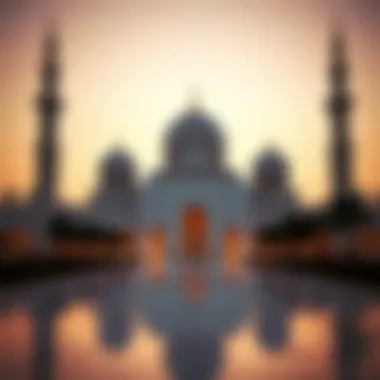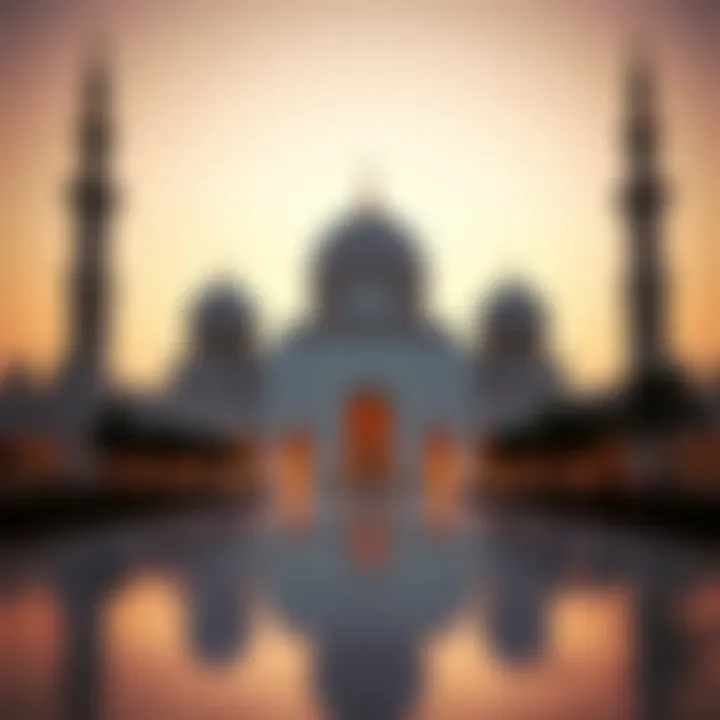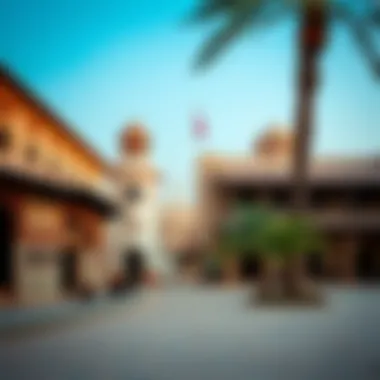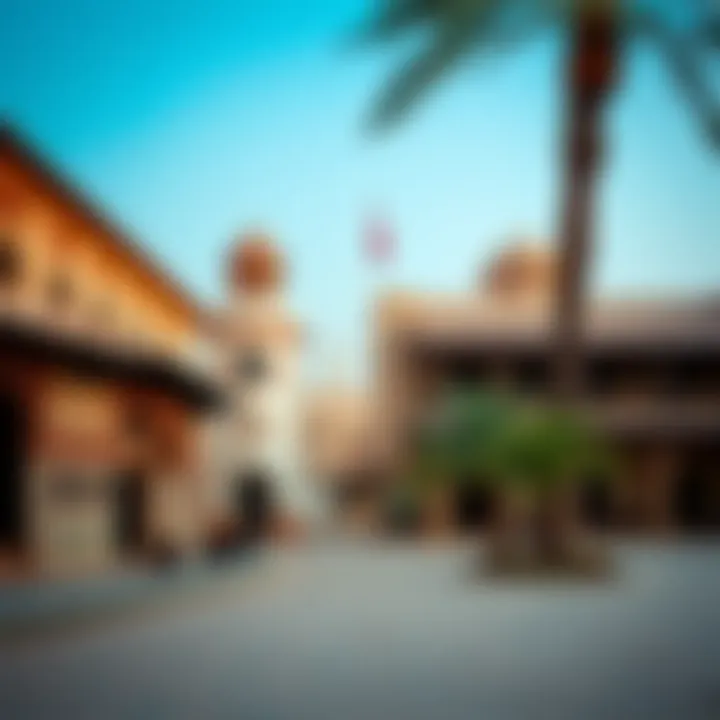Explore the Top Tourist Attractions in the UAE


Intro
The United Arab Emirates (UAE) is a land where history meets modernity, and every corner has a story to tell. From the breathtaking skyline of Dubai to the cultural richness of Abu Dhabi, each emirate showcases its own unique attractions and experiences. Whether you're a traveler seeking adventure or an investor scoping out lucrative opportunities, there’s plenty to uncover.
As we delve into the tourist attractions spread across the UAE, we will examine pivotal sites that offer both cultural significance and modern marvels. This exploration is essential not just for tourists but also for real estate enthusiasts who look to invest in this expanding market. Understanding the significance of these attractions helps to frame the broader economic and cultural tapestry of the UAE, thereby providing insights for potential property buyers and real estate investors.
Market Insights
The real estate market in Dubai, one of the most dynamic cities in the world, presents a unique blend of current trends and opportunities. As tourism continues to grow, so does the demand for both residential and commercial properties. Investors keen on tapping into this market need to stay abreast of the changing trends.
Current Trends in Dubai Real Estate
Many new developments are sprouting up across Dubai, reflecting the desires of residents and foreigners alike. Key trends include:
- Sustainability Initiatives: Developers are now more focused on green building practices. Projects like the Sustainable City emphasize eco-friendly living and reflect a shift toward environmental consciousness.
- Luxury Segment Boom: The luxury market continues to thrive, with high-end developments attracting wealthy investors looking for lavish residences. Areas like Palm Jumeirah and Downtown Dubai cater to this demographic, offering opulent properties and amenities.
- Affordable Housing Demand: Alongside the luxury market, there’s a rising need for affordable housing. Middle-income groups are increasingly becoming a significant segment, leading to more developments aimed at this demographic.
Key Indicators of Market Performance
To gauge the health of the Dubai real estate market, several indicators can be assessed:
- Price Trends: Real estate prices in Dubai have shown fluctuations over the years but have recently stabilized in many areas, reflecting a mature market.
- Number of Transactions: The volume of sales transactions is a telling sign; consistent increases suggest confidence among investors.
- Rental yields: Investors often look at rental yields as a sign of a fruitful investment. In Dubai, certain areas yield up to 8%, making it an attractive destination for buy-to-let strategies.
Investment Strategies
If you’re eyeing the UAE real estate market or perhaps wishing to expand your portfolio, understanding strategic approaches is critical.
Smart Buying Tips for First-Time Investors
For first-time investors, the UAE market may seem daunting, yet with the right approach, it can yield significant rewards:
- Research is Key: Before making any commitment, take the time to understand the areas of interest. Delve into demographics, amenities, and future developments.
- Consult Local Experts: Engage with local real estate agents who can provide insights that you might not find elsewhere. Their knowledge of the market can guide you comfortably through the purchasing process.
- Start Small: Begin with smaller investments to familiarize yourself with the market dynamics. After understanding the landscape, you can gradually scale up your investments.
Understanding Rental Yields and ROI
Analyzing potential returns is fundamental for any investor:
- Location Matters: Properties in prime locations usually command higher rental prices, thereby offering better yields.
- Seasonal Demand: The tourism influx during peak seasons can spike rental demand. Understanding these fluctuations can enable you to optimize your rental strategy.
- Long-term Value: Focus on the long-term potential of properties. Areas slated for development can experience value hikes as infrastructure improves.
The UAE, marked by its majestic landscapes and thriving cities, holds an abundance of opportunities for both tourists and investors. Those who approach the market with informed strategies are likely to find prosperous paths ahead.
"The best time to buy a property in Dubai was yesterday; the second best time is now."
To learn more about the real estate market and tourism dynamics, check out Wikipedia or engage with communities on Reddit. with insights spanning a myriad of sources for comprehensive understanding.
Prelims to the Emirates
The United Arab Emirates (UAE) stands as a symphony of modernity and tradition, a place where the sands of time tell stories from the past while the skyline pierces the present. Understanding the UAE is essential for any traveler or investor interested in its tourist attractions. The allure isn’t just about the beautiful edifices or shopping malls; it’s also about diving deeper into the heart and soul of this captivating nation.
Geographical Overview
Geographically, the UAE is nestled in the southeast corner of the Arabian Peninsula. Its diverse landscape ranges from vast deserts to picturesque coastlines, offering a unique backdrop for various activities and experiences. The seven emirates—Abu Dhabi, Dubai, Sharjah, Ajman, Umm Al-Quwain, Fujairah, and Ras Al Khaimah—each have distinct characteristics. For instance, while Abu Dhabi boasts of serene beaches and a wealth of cultural heritage, Dubai dazzles with its skyscrapers and bustling lifestyle. The Hajar Mountains in Fujairah contrast sharply with the sandy expanses of the Rub' al Khali desert, providing ample opportunities for nature lovers and adventurers alike.
The UAE’s strategic location is also noteworthy. Positioned as a gateway between Europe and Asia, it serves as a nexus for trade and tourism. This geographical advantage has attracted investors and tourists from across the globe, making the UAE a melting pot of cultures, lifestyles, and businesses.
Cultural Significance
The cultural tapestry of the UAE is woven from various threads, each contributing to the richness of its identity. At its core, the UAE's culture is deeply rooted in Islamic traditions, reflected in its art, music, and festivals. Cultural festivals, such as the Sharjah Biennial and Dubai Shopping Festival, attract global audiences, showcasing the UAE's commitment to arts and culture.
Moreover, the UAE's heritage is preserved through various museums and traditional sites, such as the Sheikh Zayed Grand Mosque in Abu Dhabi, which stands as a testament to architectural brilliance and cultural dialogue. The UAE places a significant emphasis on maintaining its traditions while embracing modernity.
As the nation continues to forge its path, balancing tradition and innovation, it remains a focal point for cultural exchange, making it an important study for anyone looking to understand the evolving global landscape.
"The UAE is not just about structures made of glass and steel; it tells a rich story of a people, their traditions, and their unwavering spirit."
The blend of geographical diversity and rich cultural significance makes the UAE an enticing destination for travelers and investors alike, offering endless possibilities and a vibrant atmosphere that is difficult to replicate.
Dubai: The Center of Modernity
Dubai serves as a shining beacon of modernity in the United Arab Emirates, embodying a blend of traditional heritage and futuristic ambition. Its skyline is punctuated by architectural wonders and luxurious venues that draw visitors from all corners of the globe. As we navigate through the sections below, we will delve into three of Dubai's most iconic attractions: the Burj Khalifa, Dubai Mall, and Palm Jumeirah. Each of these landmarks not only showcases a unique facet of Dubai's character but also presents various opportunities for investors, homeowners, and developers.
Burj Khalifa
Standing tall at a staggering height of 828 meters, the Burj Khalifa is not only the tallest building in the world but also a symbol of Dubai's ambitions. This architectural marvel was completed in 2010 and has since become a central point in the city's skyline. Visitors are often captivated by the observatory decks located on the 148th floor, offering sweeping views of the city and beyond.
The Burj Khalifa is also home to a variety of living spaces, corporate offices, and the luxurious Armani Hotel. Its presence enhances the real estate market in Dubai, appealing to both luxury seekers and investors. Importantly, the building incorporates environmental considerations, boasting energy-efficient technology throughout. The Burj Khalifa exemplifies how contemporary architecture can marry functionality with beauty.
Dubai Mall
Just a stone's throw away from the Burj Khalifa lies the Dubai Mall, the largest shopping and entertainment destination in the world. With over 1,200 retail outlets, the mall caters to all tastes and budgets. From high-end luxury brands to local boutiques, visitors can find a diverse shopping experience under one roof.
The Dubai Mall doesn’t just stop at shopping; it is also packed with attractions such as the Dubai Aquarium and Underwater Zoo, outdoor fountains, and an ice rink. For investors, the foot traffic generated here presents ongoing opportunities for retail businesses and dining venues. As a hub of entertainment, it reinforces Dubai’s position as a leading tourist hub, further backing its appeal in the global market.


Palm Jumeirah
Palm Jumeirah, known for its tree-like shape when viewed from above, exemplifies the innovative spirit of Dubai. This palm-shaped island features upscale hotels, fine dining, and residential spaces, making it one of Dubai's most sought-after locations. The island is not just an engineering feat but also a lifestyle destination for both tourists and locals alike.
Living on Palm Jumeirah offers easy access to private beaches and stunning views of the Arabian Gulf, which is a significant draw for high-net-worth individuals. Investors can take advantage of the diverse property offerings, from villas to high-rise apartments, all of which are perched over the pristine waters of the coast. This site perfectly encapsulates Dubai's luxury living and serves as a strong foundation for further real estate developments.
"Dubai is not just a place; it’s a phenomenon that continuously transforms and evolves."
In summary, Dubai stands at the forefront of modernity in the UAE, and its landmark attractions are more than just sites of interest—they are key players in the region's economic and cultural development. For investors and real estate enthusiasts, understanding the gravity of these attractions can lead to informed decisions that align with Dubai's growing market.
Abu Dhabi: The Cultural Heart
Abu Dhabi, as the capital of the United Arab Emirates, holds a significant place in the nation’s fabric, weaving together both tradition and modernity. This emirate is not just a seat of political power but a hub for arts, culture, and heritage. Visitors often find that it represents the essence of Emirati identity, offering a blend of historical and contemporary attractions that reflect a commitment to cultural preservation and innovation.
One can easily get lost in the grandeur of its monumental architecture and rich history. Abu Dhabi stands out because it showcases the UAE’s efforts to cultivate a strong sense of identity while adapting to globalization. For investors, homeowners, and developers, the cultural richness of Abu Dhabi presents viable opportunities for real estate and tourism-driven ventures, especially as the demand for culturally-rooted experiences continues to rise.
Sheikh Zayed Grand Mosque
The Sheikh Zayed Grand Mosque is emblematic of Abu Dhabi’s cultural ethos. It is a masterpiece that combines various architectural styles, embodying both Islamic and contemporary designs. Spanning over 30 acres, this mosque can accommodate around 41,000 worshippers.
Visiting this iconic site offers more than just a spiritual experience; it is a window into the artistry and dedication of Emirati craftsmanship. The white marble structure, adorned with intricate floral motifs and reflective water pools, captivates the hearts of millions. The main prayer hall features one of the world's largest chandeliers, which draws visitors not only for its size but for its exquisite design. The mosque offers regular guided tours, making it a hit among tourists and a crucial point of interest for cultural enthusiasts. A trip to Abu Dhabi feels incomplete without experiencing the grandeur of this mosque.
Louvre Abu Dhabi
The Louvre Abu Dhabi stands as a beacon of culture and learning. Established as a collaboration between France and the UAE, this museum is not merely an exhibit space; it is a cultural bridge connecting civilizations. The museum’s design is a spectacle, with its striking dome casting a playful interplay of light and shadow across the galleries, creating an atmosphere that is both ethereal and welcoming.
Within its walls, the museum houses a collection that spans thousands of years, showcasing art from across the globe. The diverse exhibits represent multiple cultures and histories, inviting discussions on shared human experiences. For investors, the Louvre serves as a key attraction, drawing art lovers and tourists alike, which in turn fosters growth in nearby real estate and hospitality sectors. The establishment of this museum helps to position Abu Dhabi as a global cultural destination.
Emirates Palace
Emirates Palace is not just a luxury hotel but a historical landmark. It epitomizes Arabian hospitality and opulence. The building exhibits a dazzling blend of Islamic architecture and modern luxury, catering to those with refined tastes.
Guests and visitors are often taken aback by the sheer scale of this architectural wonder, which boasts 394 rooms and suites along with 16 varied dining options, some offering an experience like no other. One can feast on gold-flaked treats or enjoy traditional Emirati dishes. The Emirates Palace also serves as a venue for high-profile events and cultural festivals, making it integral to Abu Dhabi's social calendar.
Moreover, the hotel’s investments into environmental sustainability and conservation practices resonate with the growing global focus on eco-friendly tourism. This forward-thinking approach bodes well for future development in the emirate’s hospitality industry.
The cultural landmarks of Abu Dhabi not only attract tourists from afar but also serve as a reminder of the UAE’s commitment to nurturing its heritage while forging ahead into the future.
In summary, Abu Dhabi, with its major attractions such as the Sheikh Zayed Grand Mosque, Louvre Abu Dhabi, and Emirates Palace, stands as the cultural heart of the UAE. Each location offers insights into the nation’s values and ambitions, ultimately paving the way for sustainable tourism and real estate opportunities.
Sharjah: The Cultural Capital
Sharjah, often dubbed the cultural heart of the UAE, stands out amid the glitzy skyscrapers and bustling souks of its neighboring Emirates. It boasts a unique blend of tradition and modernity that intrigues not just tourists but also art lovers and history enthusiasts. Unlike Dubai's flashy attractions or Abu Dhabi's opulence, Sharjah nurtures a deep appreciation for heritage and artistic expression. This dedication to culture is so strong that UNESCO has recognized it as the Islamic Culture Capital.
The importance of Sharjah lies in its rich tapestry woven from arts, education, and cultural preservation. Visitors who wander through its streets will find themselves experiencing the true essence of Emirati identity. It is not merely about observation; it’s an engagement with the past and present, fostering a sense of community and belonging among its residents and visitors alike.
Sharjah Art Museum
The Sharjah Art Museum is a cornerstone of the Emirate's cultural landscape. Housing an expansive collection of both contemporary and traditional art, it's a must-visit for anyone keen on understanding the instrumental role of art in society. More than 500 pieces from renowned artists not just from the region but worldwide grace its walls.
Visitors might find excitement in the frequent exhibitions and workshops that showcase emerging talents. These events bring a sense of freshness and dynamism to the museum, allowing for a richer understanding of global artistic trends.
These features make the museum an appealing destination not only for art aficionados but also for investors who appreciate the value of cultural equity in urban settings. Art, in this sense, offers a solid foundation for community cohesion and economic development.
Heart of Sharjah
Not far from the museum lies the Heart of Sharjah, which is a meticulously restored part of the Emirate. This area provides a glimpse into historical architecture and the cultural heritage of the region. The Heart of Sharjah showcases several museums, galleries, and cultural spaces that invite exploration.
Walking through its winding alleys feels like stepping back in time, where historic buildings stand tall against the backdrop of continuing modern development. The initiatives here are not only about preservation but also about fostering creativity and connecting the past with the future.
For investors in the tourism and real estate sectors, this area presents opportunities to be part of a growing movement that promotes cultural tourism, thus increasing foot traffic and engagement in local businesses.
"Sharjah is a living museum where every corner tells a story, making it an exceptional place for both tourists and investors looking to connect with the local culture."
Ras Al Khaimah: Nature and Adventure
Ras Al Khaimah, the northernmost emirate of the UAE, is often overshadowed by the glitz and glamour of Dubai and Abu Dhabi. However, it offers a rich tapestry of experiences for nature lovers and adventure seekers alike. This emirate is a hidden gem, characterized by its majestic mountains, pristine beaches, and a variety of outdoor activities that allow travelers to connect with nature and enjoy unparalleled adventures. The attraction here lies not just in the landscapes, but in the unique experiences available, making it a worthy consideration for tourists and real estate investors alike.
Jebel Jais
Jebel Jais, the highest peak in the UAE, stands as a beacon for thrill-seekers. Reaching a towering height of 1,934 meters, this mountain offers breathtaking views that extend far beyond the horizon. The road that winds around the mountain is a marvel in itself, providing a scenic drive filled with winding turns and stunning vistas. Visitors can engage in an array of activities such as hiking, rock climbing, and zip-lining—the latter being the longest of its kind in the world, stretching over 2.8 kilometers.
The zip line experience, in particular, is a heart-pounding way to take in the sights, allowing participants to soar through the air with panoramic views of the Hajar Mountains below. Even if one’s interests lean more towards gentle pursuits, the hiking trails cater to various skill levels. From easy treks to challenging routes, there’s something for everyone, ensuring that every visitor has the opportunity to relish the natural beauty.
"Jebel Jais is not just about heights and thrills; it’s about immersing oneself in the serenity that nature offers."
Khasab Fort
Khasab Fort, a historical jewel, is tucked away in the scenic surroundings of Ras Al Khaimah, reflecting the rich culture and history of the region. Originally built in the 17th century, this fortress served as a stronghold and a watchtower, safeguarding the local community. It now stands as a testament to the architectural style of the time, with its robust stone walls and traditional Emirati design.
Exploring Khasab Fort transports visitors to a different era. The fort provides guided tours that delve into the history of the region, offering insights into the lifestyle of its people and their fortifications against invaders. The panoramic views from the ramparts are equally captivating, offering a glimpse of the surrounding landscape and the azure waters of the Arabian Gulf.
Moreover, Khasab Fort enhances the overall experience of Ras Al Khaimah by showcasing the emirate’s commitment to preserving its heritage and promoting cultural tourism. For real estate investors and developers, the integration of such historical sites into the touristic fabric adds value to the community, drawing a diverse range of visitors interested in both leisure and education.
Ajman: A Gem of Tranquility
Ajman, though the smallest emirate in the United Arab Emirates, doesn’t skimp on offering a unique blend of experiences that resonate with visitors seeking peace and a good time. Often overshadowed by its more flamboyant neighbors like Dubai and Abu Dhabi, Ajman brings a charm that lies in its serene surroundings and rich history. It boasts beautiful coastlines, inviting beaches, and a welcoming culture that beckons both tourists and investors alike.


In our exploration of Ajman as a notable destination within the UAE, we’ll dive into two specific attractions that encapsulate its tranquil essence: the Ajman Museum and Ajman Beach. Both spots hold significant value for travelers looking to unwind and appreciate the emirate’s history, natural beauty, and cultural depth.
Ajman Museum
Nestled in the heart of Ajman, the Ajman Museum offers a window into the emirate's past. Housed in an elegantly restored fort, which dates back to the late 18th century, visiting the museum is akin to stepping back in time. The fort itself is an architectural gem, showcasing traditional Emirati design, complete with wind towers and ornate plasterwork.
Inside, the museum is divided into several exhibits, emphasizing aspects of local life, history, and culture. You’ll find artifacts ranging from ancient weapons to traditional costumes, encapsulating the stories of the people who once inhabited this region.
Key highlights include:
- Artifacts found in archaeological digs across the emirate
- Exhibitions on maritime history, reflecting Ajman's connection to the sea
- Displays of jewelry and household items used in pre-oil economic times
Visitors often leave with a greater appreciation for Ajman, understanding how its culture has evolved while maintaining elements of its rich heritage. Those interested in real estate may find insights into the historical significance reflected in local architecture, potentially influencing cultural preservation in future developments.
“The Ajman Museum serves not just to showcase the emirate's rich history but to inspire the next generation of architects and planners in preserving the UAE’s identity.”
Ajman Beach
Another crown jewel is Ajman Beach, stretching along the coast with brilliant white sands and calming waves. This beach is an ideal destination for families and individual travelers seeking solace away from the hustle of city life. The shoreline features well-maintained facilities, making it an accessible retreat for all.
Here, you can engage in a variety of activities or simply soak up the sun, with the option to partake in water sports like jet skiing or paddleboarding. Alongside this, local cafes offer refreshing beverages beachside, perfect for relishing the sun’s warmth with a cool drink in hand.
Some noteworthy aspects of Ajman Beach include:
- Accessibility: With wide-spanning public access, it’s easy for families to find a spot to settle down and enjoy a day out.
- Cleanliness: The beachfront is well-managed, and you’re likely to find it clean and safe, reflecting the emirate's commitment to tourism.
- Affordability: Compared to its pricier counterparts in Dubai, Ajman Beach provides an alternative that often comes with less crowd and a more relaxed atmosphere.
Tourism in Ajman is growing, backed by government initiatives aimed at boosting the emirate’s profile as a coastal getaway. This not only benefits visitors but also highlights potential investment opportunities in local hospitality and recreational sectors.
As we assess Ajman’s tranquil offerings, it's clear that the emirate stands poised as an attractive destination for those seeking a balance of culture, comfort, and relaxation on their travels through the UAE.
Fujairah: The Coastal Paradise
Fujairah, the only emirate located on the eastern coast of the UAE along the Gulf of Oman, offers a striking contrast to the other more urbanized emirates. It is often recognized for its natural beauty and rich historical significance, making it a much-needed retreat for those looking to escape the bustling pace of city life. Here, the mountains meet the sea, creating a unique landscape that beckons not only tourists but also investors and homebuyers looking to tap into opportunities beyond the glitzy urban centers. Here’s why Fujairah is a treasure worth exploring.
Fujairah Fort
Fujairah Fort stands as a testament to the region’s deep-rooted heritage. This structure, which dates back to the 16th century, is one of the largest forts in the UAE and showcases traditional Arabic architecture. Originally built to protect the town and its vital resources, the fort has played a pivotal role in the historical narrative of Fujairah.
Visitors can wander through its winding corridors and explore a museum on the first floor that reveals artifacts and tools that illustrate the emirate’s past. The view from the fort's towers is nothing short of breathtaking, overlooking the lush date palms that lie below and the distant mountains rising majestically behind.
"Fujairah Fort isn't just a structure; it’s the foundation of identity for many who call Fujairah home."
Sandy Beaches
Fujairah's coastline is lined with pristine beaches that showcase the region's unique charm. Unlike the more commercialized beach destinations in other emirates, Fujairah's sandy stretches are often quieter and less crowded, making them ideal for a serene day of sunbathing or swimming. The clear waters, rich in marine life, invite water sports enthusiasts for activities like snorkeling and diving.
Some notable beaches include Al Faqeet Beach and Sandy Beach, each offering soft, golden sands framed by the rugged Hajjar Mountains. Here, you can spend hours soaking up the sun, enjoying a family picnic, or simply taking long, leisurely walks along the shore. For many, these beaches provide a refreshing contrast to the glitzy and crowded tourist spots elsewhere in the UAE.
Investors and developers are beginning to recognize the potential of these beautiful coastal areas, as they look to build more opportunities in hospitality and leisure, providing growth that is sustainable and aligned with the stunning natural landscape.
In summary, Fujairah, characterized by its historical fort and beautiful beaches, isn't just another destination in the UAE but a unique coastal paradise. Its blend of culture, history, and natural beauty makes it a focal point for those looking to invest and immerse in a more relaxed lifestyle.
Umm Al-Quwain: The Traditional Experience
Umm Al-Quwain, one of the less-explored gems of the United Arab Emirates, presents a unique blend of traditional culture and serene landscapes. Unlike its bustling neighbors, Umm Al-Quwain offers a more laid-back experience that allows visitors to step back in time and immerse themselves in the rich heritage of the region. It’s a place that speaks volumes about the UAE's heritage, showcasing the humble yet profound lifestyle that defined earlier generations.
The emirate is often overlooked, which actually works to its advantage, granting it a peaceful ambiance unspoiled by mass tourism. For those seeking to understand the traditional emirate lifestyle, Umm Al-Quwain provides a canvas rich in history and culture. Because of this significance, it plays a crucial role in the tourist scene within the UAE, attracting both travelers interested in heritage and investors looking at real estate opportunities that encourage cultural appreciation and sustainable development.
Umm Al-Quwain Museum
The Umm Al-Quwain Museum is a quintessential stop for those wanting to dive deep into the local history. Housed in a former palace of the emirate's ruling family, the museum is a treasure trove of artifacts that narrate stories of the past. Visitors can wander through exhibits showcasing ancient tools, traditional garments, and photographs that illustrate the emirate's development over the years.
Some key highlights from the museum include:
- Archaeological Finds: The museum features items unearthed from nearby archaeological sites that date back thousands of years, offering insights into the lives of early settlers in the area.
- Copper artifacts: Early copper tools and utensils reflect the craftsmanship of the time and provide a tangible connection to past human activity.
- Traditional Heritage: There are displays dedicated to the UAE's maritime history, which is particularly relevant in Umm Al-Quwain, a coastal emirate.
"The museum serves as a window into the soul of Umm Al-Quwain, bridging the past with the present."
For real estate enthusiasts, the museum's presence adds value to the area, highlighting a niche market that appreciates culture and history.
Dreamland Aqua Park
For families seeking a blend of fun and relaxation, Dreamland Aqua Park is a perfect choice. This water park is one of the largest in the UAE, offering an impressive array of attractions that cater to both thrill-seekers and those looking for a leisurely day under the sun. The expansive layout ensures that visitors aren't crammed together, allowing for a more relaxed experience.
- Water Attractions: From exhilarating water slides to lazy rivers, the park is well-equipped with various options to suit all ages. The wave pool mimics the experience of the sea without the currents, ideal for families with younger children.
- Amenities: Dreamland Aqua Park takes care to cater to its visitors with a variety of dining options and shaded areas, ensuring comfort is paramount during hot days.
- Natural Setting: Nestled amongst palm trees, the park offers a refreshing escape from the desert heat, blending entertainment with the beauty of nature.
The presence of such recreational facilities enhances Umm Al-Quwain's appeal, showcasing the emirate’s potential not only as a cultural retreat but also as a hub for leisure activities. For investors, the aqua park is more than just a visitor attraction; it signifies growth potential in tourism and related sectors.
Emerging Attractions in the UAE
As the landscapes of the UAE evolve, new attractions emerge that capture the essence of innovation and cultural richness. The importance of discussing emerging attractions lies in illustrating the dynamic nature of tourism within the Emirates. These newly established sites not only draw visitors but also present lucrative opportunities for investors and developers. With the backdrop of a rapidly growing economy, these attractions contribute significantly to the overall appeal of the UAE as a prime tourist destination.
Theme Parks


Theme parks in the UAE have evolved into spectacles of creativity and entertainment, becoming a vital part of the country’s tourism narrative. Recent additions like Dubai Parks and Resorts, which includes Motiongate and Legoland, have significantly redefined the family entertainment landscape. From thrilling rides to immersive experiences based on popular films, these parks attract families from various demographics, making it a family-friendly environment for international visitors.
Moreover, these parks create substantial job opportunities, benefiting the local economy directly. The surge in visitors further magnifies the need for associated infrastructure, enriching the real estate and hospitality sectors.
Key benefits of the theme parks:
- Diverse Attractions: From heart-pounding roller coasters to serene zones for younger children.
- Cultural Integration: Parks often incorporate elements of local culture, appealing to both local and international audiences.
- Economic Growth: Increased tourism spurs growth in various sectors, from hospitality to retail.
Eco-Tourism Initiatives
As concerns for the environment intensify globally, the UAE is making strides to embrace eco-tourism. This emerging focus not only highlights the nation’s commitment to sustainability but also appeals to eco-conscious travelers. Initiatives like the Al Marmoom Desert Conservation Reserve promote the importance of preserving natural landscapes while offering unique experiences, such as wildlife safaris and stargazing events.
The appeal of eco-tourism in the UAE brings several dimensions:
- Conservation Awareness: Promoting education about local wildlife and habitats encourages a sense of responsibility among visitors.
- Unique Experiences: Activities like eco-friendly camping provide alternative ways to explore the beautiful landscapes of the UAE.
- Support for Local Communities: Eco-tourism often involves local communities in conservation efforts, creating economic opportunities while preserving culture and tradition.
"The UAE's commitment to sustainable tourism reflects a balance between luxury and environmental responsibility, setting a precedent for future developments."
Cultural Festivals and Events
Cultural festivals and events in the United Arab Emirates play a crucial role in defining the country's identity. They not only celebrate traditions and customs but also attract countless visitors each year, fostering a deep appreciation for the region's rich heritage. These festivities create a bridge between local communities and the international audience, making them vital in promoting tourism and enhancing cultural exchange.
Dubai Shopping Festival
The Dubai Shopping Festival (DSF) is much more than simply a retail event; it's almost like a citywide carnival of discounts, promotions, and entertainment. Launched in 1996, this month-long extravaganza usually kicks off in January, transforming Dubai into a shopper's paradise. Visitors can expect massive sales across numerous malls, local markets, and even individual stores, bringing unparalleled savings on global brands.
However, the festival's allure goes beyond shopping discounts. Street performers, fireworks displays, and cultural shows permeate the city, attracting diverse crowds. Families can partake in exciting activities, such as kids' concerts and themed attractions, while adults can enjoy gourmet food experiences showcasing the flavors of the UAE and beyond.
Considerations for those looking to invest or engage with the local tourism scene during DSF include recognizing its direct impact on consumer spending. Since its inception, the festival has boosted the retail sector significantly, making it a fabulous time for real estate enthusiasts and business owners to capitalize on increased footfall and tourist interest.
Abu Dhabi Film Festival
The Abu Dhabi Film Festival (ADFF) holds an esteemed position in the film industry, especially in the Arab world. This annual festival began in 2007, with the aim of fostering cultural dialogue and showcasing unique voices in cinema. Held in October, the festival features a diverse lineup of films, ranging from international blockbusters to indie projects, including many from local filmmakers.
What makes ADFF distinct is its commitment to supporting talent and creativity in the region. Workshops, panels, and networking events, often led by industry veterans, provide invaluable insights to emerging filmmakers and offer a platform for collaboration. The festival also dedicates awards to recognize outstanding films and filmmakers, heightening the prestige of participating productions.
With the film industry on the rise in the UAE, the Abu Dhabi Film Festival presents noteworthy investment opportunities. For investors, aligning with film productions can lead to lucrative returns, particularly as the Arabian cinematic landscape continues to expand globally. Engaging with this festival can thus function as a gateway to understanding broader cultural trends and consumption patterns.
Cultural festivals bridge heritage and modernity, connecting communities with a global audience.
Investment Opportunities Linked to Tourism
Tourism plays a pivotal role in shaping the economy of the United Arab Emirates, presenting both profitable avenues and a canvas for sustainable development. The growth in tourist inflow has opened numerous investment opportunities that can be lucrative for various stakeholders, including investors, homeowners, realtors, and developers. As the UAE looks towards a diversified economy beyond oil, the tourism sector stands as a beacon for future growth.
Real Estate Developments
In recent years, the real estate market in the UAE has witnessed a boom, largely fueled by the burgeoning tourism sector. The demand for accommodations such as hotels, serviced apartments, and villas has surged, compelling developers to consider innovative projects that cater to a diverse clientele.
- Strategic Locations: Locations near major attractions like the Burj Khalifa and Sheikh Zayed Grand Mosque have become gold mines for real estate developers. Properties in these areas not only offer high occupancy rates but also upscale value as tourism flourishes.
- Mixed-Use Developments: Projects that combine residential, commercial, and leisure facilities are increasingly attractive. For instance, the development of the Dubai Creek Harbour integrates hotels, residential spaces, and entertainment zones, catering to both tourists and residents.
- Sustainability: In light of global shifts towards sustainability, there’s a growing opportunity to invest in eco-friendly and sustainable housing projects. Properties using green technology attract eco-conscious tourists, adding another layer of desirability.
Investors looking to jump on the bandwagon should stay updated on government regulations facilitating foreign investment. The UAE government has introduced various visa options and incentives to foster a welcoming environment for overseas property buyers, including the golden visa system, which is aimed at long-term investors.
Hospitality Sector Growth
The hospitality sector in the UAE is not merely growing; it’s transforming. With increasing international arrivals, hotels and resorts are adopting new strategies to enhance guest experience and maximize profitability.
- Luxury Market Expansion: The expansion of luxury brands in the UAE signifies a robust hospitality sector. High-end hotels like the Ritz-Carlton and Burj Al Arab have set a gold standard, attracting affluent tourists. This trend has prompted substantial investment opportunities in posh property developments.
- Budget-Friendly Options: On the flip side, budget hotels and hostels are also gaining traction. A substantial segment of tourists seeks affordable yet comfortable accommodations, prompting investors to consider this niche market as viable.
- Event-Centric Facilities: The UAE hosts numerous events such as the Abu Dhabi Film Festival and the Dubai Shopping Festival. Hotels offering state-of-the-art conference and banquet facilities are becoming vital venues, leading to more investments in hospitality infrastructure.
The hospitality sector's adaptability to current trends allows investors to allocate resources effectively. Whether focusing on luxury or budget travel, understanding the evolving preferences of tourists can drive successful investments in this flourishing market.
The tourism landscape of the UAE is not just about the attractions; it’s about the investment opportunities that ride on the growth of this vibrant sector.
For further insights into the UAE tourism landscape, you can reference resources like Wikipedia and Britannica.
For more up-to-date discussions, check platforms like Reddit or social media channels.
End: The Future of Tourism in the UAE
The tourism landscape in the United Arab Emirates (UAE) is not just about basking under the sun or shopping till you drop. It has evolved into a multi-dimensional sector that influences various aspects of life within the Emirates. Moving forward, this industry carries the weight of expectations from multiple stakeholders—be it investors, government agencies, or the local populace. The importance of discussing the future of tourism in the UAE lies in understanding its trajectory and preparing for the unfolding opportunities that lie ahead.
Sustainability has emerged as a central theme in shaping the future of tourism. As the UAE positions itself as a leader in eco-tourism initiatives, the balance between development and environmental conservation becomes more crucial. Tourists today are not just looking for leisure but also experiences that respect nature and local cultures. The implication here is profound: without sustainable practices, the very attractions that draw millions could degrade, turning what was once a booming sector into an echo of lost potential.
Sustainability and Tourism
Sustainability is more than a buzzword; it is a necessity in the current tourism climate. The UAE has made significant strides toward green tourism, aiming to attract visitors seeking eco-friendly experiences. Initiatives like the establishment of wildlife reserves, conservation projects, and sustainable hotels are essential elements in this shift. By investing in renewable energy sources and encouraging local communities to participate in tourism, the UAE is not only nurturing its environment but also enriching its cultural heritage.
- Local Engagement: Empowering local communities to engage in tourism offers not only economic benefits but also ensures that cultural integrity is maintained. This creates a more authentic experience for visitors.
- Green Certifications: Hotels and restaurants are increasingly being encouraged to adopt green practices, which not only help in conserving resources but also appeal to eco-conscious travelers.
- Awareness Campaigns: The government and various organizations have launched campaigns to educate the public and travelers about the importance of preserving the environment.
In summary, sustainability is not an option but a vital consideration for the future of tourism in the UAE. Without it, the promise of a diverse and thriving tourism sector could unravel, leaving a significant gap in cultural and economic vitality.
Forecast for Growth
As we think about the future, the growth forecasts for tourism in the UAE appear bright, driven primarily by diversification and innovation. As new attractions are added and existing ones are upgraded, the country is poised to draw even larger crowds.
- New Infrastructure: The development of transport links and airport expansions sets the stage for increased inflow of tourists, making it easier and more convenient to visit.
- Cultural Offerings: Events like the Abu Dhabi Film Festival or the Dubai Shopping Festival are not just seasonal occurrences; they are steps toward creating a year-round tourism calendar that attracts more visitors.
- Real Estate Developments: With projects like Dubai Creek Tower and various luxury resorts, investors continue to see the potential return on investment in hospitality and leisure sectors.
The results of these initiatives indicate robust growth rates, projected to enhance the overall contribution of tourism to the national economy significantly. The push for tourism, aimed at diverse visitor demographics, will also cater to families, adventure seekers, and cultural enthusiasts alike.
Overall, the future of tourism in the UAE blends innovation and sustainability, promising new opportunities for growth while maintaining respect for cultural roots. As the nation moves toward hosting more international events and experiences that appeal to a wider audience, a symbiotic relationship between tourism and the community can flourish, ensuring a bright and prosperous future.







